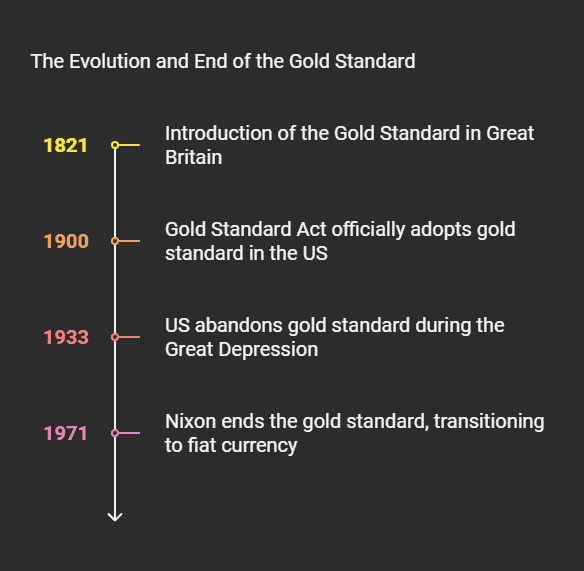
It is no secret that gold is one of the most valuable chemical elements in the entire world. It has been used to exchange goods and services for centuries prior to the introduction of national currencies, but even after that, it continued to play an important role in shaping the global economy.
In fact, gold was used to ensure the value of national currencies in a number of countries around the world, including the United States. This practice became known as the gold standard. For decades, it was considered to be one of the most effective ways to maintain the value of the US dollar and protect it against inflation.
The rise and fall of the gold standard, as well as its subsequent impact on the American and global economy remains the subject of heated monetary policy debates among economists. Should the gold standard have been abandoned? Or is it true that it was no longer sufficient to keep up with the needs of the markets?

Key Takeaways
- The gold standard is a form of monetary policy where the value of the currency is linked with the value of gold
- It was first implemented in Great Britain in 1821 and in 1900 in the United States
- In 1971, all remnants of the gold standard were abandoned in the US and replaced by fiat money
Gold Standard: Definition
The gold standard is a monetary policy in which a country’s currency is pegged to the value of gold, and can be freely exchanged for it. In practice, this means that the value of the national currency of a country that has adopted the gold standard cannot exceed the current value of a gold unit. Keep in mind that it is the country itself that determines the value of gold in its currency.
For example, if the Federal Reserve set the value of an ounce of gold at $100 (of course, this is just an example, the real value would probably be much higher), then the value of the American dollar would be at 1/100 of that. This way, converting the US dollar into gold is done easily and keeps the currency stable.
Gold – The Ultimate Currency
Before diving into the history of the gold standard in the United States and abroad, we first need to understand why gold was chosen as the ultimate unit of determining a currency’s value.
Gold has been a symbol of safety, wealth, and power for centuries. Throughout the course of history, its shimmering allure has played a crucial role in shaping economies and society. From ancient Egypt to the gold rushes in the US and Australia, the task of acquiring gold has been humankind’s perennial pursuit. But what exactly makes it so valuable?
The significance of gold as the ultimate currency primarily originates from its inherent properties. Gold is a very sturdy metal that doesn’t corrode or tarnish, making it a suitable material for creating long-lasting coins and bullion. Additionally, it is a very rare material, which further elevates its market value. The process of extracting gold from the earth is both expensive and arduous, adding to its high intrinsic value.
In past societies, gold was used directly as money. Without national currencies, as we understand them today, people exchanged gold bullion and other golden items for goods and services.
Then came the gold standard. Under this system, a person could present currency to the government and demand the equivalent value of gold. The gold standard was first implemented in 1821 by Britain and subsequently by other countries.
This universal acceptance of gold as a medium of exchange made it a suitable basis for monetary transactions worldwide. By tying a currency’s value directly to gold, governments hoped to maintain financial stability and discourage inflation.
However, maintaining the gold standard over the long term could prove problematic, especially with unprecedented economic growth like the one the world experienced in the second half of the 20th century.
While it did provide long-term price stability over centuries, short-term price levels fluctuated wildly during times of crisis or economic boom and bust cycles. Hence, while the idea might seem appealing, the reality proved to be considerably more complex.
History of the Gold Standard

The notion of using gold as the most valuable, primary source of value used to pay for items and services dates back thousands of years, with ancient societies like the Greeks and Romans using gold and silver to conduct trade. In fact, these societies minted coins from precious metals that held intrinsic value.
However, the concept of a formal gold standard, analogous to what most people understand by the term today, emerged in the 19th century. The United Kingdom was the first to implement it in 1821, and other nations followed suit. This system offered financial stability and facilitated global trade, as countries could easily convert their currencies during transactions.
Gold Standard in the United States
In the USA, the gold standard became official with the passage of the Gold Standard Act of 1900. Before that, the country operated on a bimetallic standard (gold and silver). However, the discovery of large silver deposits in the West in the late 19th century disrupted this balance, leading politicians and economists to advocate for a monometallic gold standard.
Under this system, every dollar was equivalent to approximately 1/20th of an ounce of gold. Banks could print only as much money as they had in gold reserves. This strict tying of currency to gold aimed at preventing inflation and maintaining value stability.
During periods of economic stability, the gold standard worked well. However, it struggled during crises and contributed to the deepening of the Great Depression in the 1930s. As a response to the economic downturn, President Franklin D. Roosevelt took the US off the gold standard in 1933 to boost economic recovery.
The last remnants of the gold standard were eliminated during Richard Nixon’s presidency in the early 1970s. Nixon detached the dollar from gold, making it a fiat currency, meaning its value was determined solely by market forces. Of course, those who wanted to invest in gold were still able to do so to protect their savings.
Why Did the Gold Standard End?
The end of the gold standard was a strategic decision resulting from changing economic circumstances and pressures of the mid-20th century. Throughout its history, the gold standard had its advantages, providing a hedge against inflation and instilling a higher level of certainty in the global economy.
However, it wasn’t without its drawbacks. This monetary system resulted in a limited flexibility of currencies that were fixed to gold, exposing countries to potential economic booms and busts based on fluctuating gold prices.
During the Great Depression of the 1930s, many nations realized that under the gold standard, they weren’t able to expand or contract their money supply to respond effectively to severe economic downturns precisely because of the lack of flexibility. This intense event led many states to abandon the gold standard for good.
Decades later, during the post-World War II era, an international gold exchange standard was established under the Bretton Woods system, which we’ll describe in detail later on in this article.
While this allowed currencies to be pegged to the US dollar (itself gold-backed), expansion of the global economy led to more dollars being printed than there was gold to back them. This disparity has inevitably put immense pressure on the American currency.
In 1971, President Nixon announced that the U.S. would cease exchanging dollars with gold at a fixed value. This effectively ended the Bretton Woods system and marked a historical end to the use of a gold standard for U.S. currency, promoting what we know today as the fiat money system – where the currency is backed by trust in the government rather than physical commodities like gold.
The Impact of the Gold Standard on the Economy

As much as the gold standard brought currency stability and helped drive global trade in its heydays, it wasn’t without its drawbacks. As the economist John Maynard Keynes pointed out, being tied to gold tended to keep economies static, stifling opportunities for growth and expansion.
The main disadvantage of the gold standard was its vulnerability to boom-and-bust cycles. If more gold was discovered and injected into the economy (as happened during the California Gold Rush), this led to inflation as there was more money than goods and services available.
On the other hand, if gold became scarce or if people hoarded it during economic uncertainty (like during the Great Depression), this led to deflation. Prices fell because there wasn’t enough money in circulation relative to available goods and services.
Moreover, since each country’s currency was tied directly to its supply of gold, economies with larger gold reserves had more money in circulation. This led to imbalances in international trade as it skewed power towards countries that could mine or buy more gold.
Additionally, having every nation beholden to the gold in their vaults naturally led to protectionist policies. Countries were reluctant to buy goods from abroad for fear of losing their precious gold reserves. This limitation of free trade further contributed to economic stagnation during the era of the gold standard.
Even today, discussions about returning to some form of a gold standard often arise, particularly during economic crises. However, these suggestions are typically met with significant skepticism due to past experiences.
Despite its allure of simplicity and stability seemingly guaranteed by the undeniable value of gold, transitioning back to the gold standard is seen by many as a path toward economic rigidity and instability.
What Replaced the Gold Standard?
The gold standard lasted until the 20th century, when it was replaced with the fiat money system. This change was initiated due to the economic crises and world conflicts that highlighted the inflexibility and potential instability of the gold standard.
Under the fiat money system, currencies are not backed by physical commodities but are rather government-issued and rely on public trust for their value. This system was officially established in 1971 when U.S. President Richard Nixon halted the convertibility of the U.S. dollar into gold, effectively ending the gold standard.
In a fiat system, central banks have more control over the economy as they can adjust the money supply depending on economic conditions, which was impossible under the gold standard.
However, though fiat money offers flexibility, it also introduces risks, such as inflation or hyperinflation, if the money supply is mismanaged. This new system eliminated the inherent constraint on the money supply that the gold standard imposed, making economic management more complex.
Though the fiat money system has replaced the gold standard globally, the allure of gold has never faded. Today, many investors opt for tangible assets like gold through options like IRAs that invest in this precious metal as a hedge against potential currency devaluation and economic uncertainty. History revealed that gold is a good investment that consistently held its value over centuries, despite the various changes in monetary systems.
The Bretton Woods System
In 1944, towards the end of World War II, representatives of 44 nations came together in Bretton Woods, New Hampshire, to form a new monetary policy system that became known as The Bretton Woods System.
Under this system, the US dollar was made convertible to gold at a fixed rate of $35 per ounce, while all other currencies were linked to the dollar. The logic behind this was that the US held the majority of the world’s gold reserves after WWII, and linking other currencies to the US dollar instead of directly to gold would result in a more stable international financial structure with a strong, interconnected relationship between all currencies.
The main goal of the Bretton Woods system was to avoid a return to the competitive devaluations that had worsened the Great Depression in the 1930s. Furthermore, it also provided an economic foundation to rebuild after WWII and allowed for greater monetary cooperation in complex global markets.
However, as global economies recovered and expanded, the precious metal could no longer keep up with the pace. Hence, by 1971, President Richard Nixon declared that the U.S. would no longer exchange dollars for gold at a fixed value, effectively ending the Bretton Woods System. This move, alongside a few other monetary policy changes, is often referred to as “The Nixon Shock”.
Today, we live in a world of fiat currencies – money that has value because a government maintains its value or because parties engaging in an exchange agree on its value. It is by faith and credit in the economy that these pieces of paper and digital numbers have any value. This system has allowed for greater financial flexibility and increased capacity for governments to manage economies.
While we have moved away from using gold as currency or as a direct anchor for our money’s worth, its influence has not faded entirely. Gold still plays a crucial role in our economy – central banks hold it as part of their reserves and individuals invest in it as protection against inflation and currency fluctuations.
The Value of Gold After the Gold Standard

Abandoning the gold standard didn’t have a negative impact on how much a pound of gold is worth. Quite the contrary – gold remains the king of precious metals and continues to rise in value. After all, it is a finite resource, and with each passing year, there’s less and less of it to go around.
Investors all over the world set aside portions of their money to be invested into gold precisely because of its intrinsic value and the ability to protect their wealth against galloping inflation.
Secure Your Future with Gold IRA Blueprint
A precious metals IRA is one of the best ways to protect your retirement assets from depreciation due to inflation or other unpredictable events. At Gold IRA Blueprint, we take great pride in helping our clients secure their golden years with verified, reliable advice on setting up, maintaining, and growing their individual retirement accounts. With us, you’ll learn how to ensure a sustainable, worry-free future for yourself and your family.
Article Sources
At Gold IRA Blueprint, we dive deep into the world of gold IRAs, using trusted sources to back up our insights. Our sources range from official documents to expert interviews, ensuring our content is both accurate and reliable. We also draw on research from reputable publishers to give you the most comprehensive understanding possible. Check out our editorial policy to see how we maintain our high standards for accuracy and fairness. Also make sure to check out our Financial Review Process to have a better understanding of our process.
-
Investopedia, What Was the Gold Standard?: Understanding the Historical Monetary System, https://www.investopedia.com/terms/g/goldstandard.asp
-
History.com, What Was the Gold Standard?: Exploring the Evolution of Currency, https://www.history.com/news/gold-standard-history-explained
-
The Balance, What Was the Gold Standard?: Analyzing the Economic Impact, https://www.thebalance.com/what-is-the-gold-standard-3306133
-
Investopedia, What Was the Gold Standard?: Pros and Cons of the Historical System, https://www.investopedia.com/ask/answers/08/gold-standard.asp
Authors & Disclosures
- Our content is independently written and reviewed by trusted reviewers & fact-checkers.
- We can earn money by connecting you with top Gold IRA Companies. Learn how our reviews work.
- Want to learn more? Meet our authors and explore our editorial policy.












